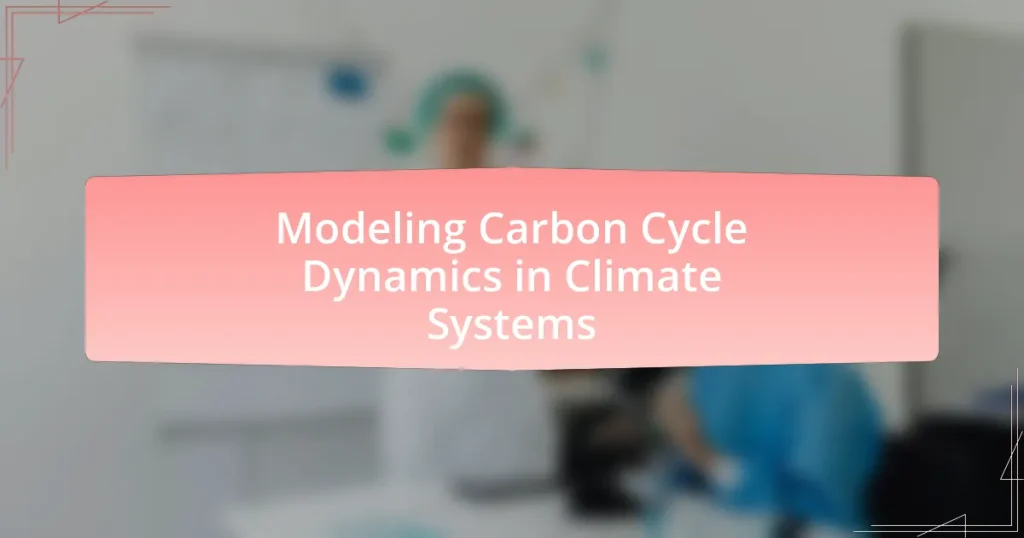Modeling carbon cycle dynamics in climate systems involves simulating and analyzing the interactions of carbon among the atmosphere, oceans, soil, and living organisms. This process is essential for understanding the impact of human activities, such as fossil fuel combustion and deforestation, on climate change. The article discusses the functioning of the carbon cycle, key processes involved, and how human actions disrupt this natural balance, leading to increased atmospheric carbon levels. It also highlights the importance of accurate modeling for predicting future climate scenarios, the challenges faced in modeling efforts, and the role of technology and collaborative approaches in enhancing model reliability and informing climate policy decisions.

What is Modeling Carbon Cycle Dynamics in Climate Systems?
Modeling carbon cycle dynamics in climate systems refers to the simulation and analysis of the interactions and processes that govern the movement of carbon among the atmosphere, oceans, soil, and living organisms. This modeling is crucial for understanding how carbon emissions from human activities, such as fossil fuel combustion and deforestation, impact climate change. Research indicates that accurate models can predict future carbon concentrations and their effects on global temperatures, as demonstrated by studies like the Coupled Model Intercomparison Project (CMIP), which provides a framework for comparing climate models and their projections.
How does the carbon cycle function within climate systems?
The carbon cycle functions within climate systems by regulating the flow of carbon among the atmosphere, oceans, soil, and living organisms. This cycle involves processes such as photosynthesis, respiration, decomposition, and ocean-atmosphere exchange, which collectively maintain the balance of carbon dioxide levels in the atmosphere. For instance, photosynthesis by plants absorbs carbon dioxide, while respiration and decomposition release it back into the atmosphere. According to the Intergovernmental Panel on Climate Change (IPCC), human activities, particularly fossil fuel combustion and deforestation, have significantly disrupted this natural cycle, leading to increased atmospheric carbon levels and contributing to global warming.
What are the key processes involved in the carbon cycle?
The key processes involved in the carbon cycle are photosynthesis, respiration, decomposition, and combustion. Photosynthesis occurs when plants absorb carbon dioxide from the atmosphere and convert it into organic matter using sunlight. Respiration is the process by which living organisms, including plants and animals, release carbon dioxide back into the atmosphere as they metabolize organic matter for energy. Decomposition involves the breakdown of dead organic material by microorganisms, which releases carbon back into the soil and atmosphere. Combustion refers to the burning of fossil fuels and biomass, which releases stored carbon dioxide into the atmosphere. These processes are interconnected and play a crucial role in regulating Earth’s carbon balance and climate.
How do human activities influence the carbon cycle?
Human activities significantly influence the carbon cycle primarily through the burning of fossil fuels, deforestation, and industrial processes. These actions release large amounts of carbon dioxide into the atmosphere, disrupting the natural balance of carbon exchange between the atmosphere, oceans, and terrestrial ecosystems. For instance, the combustion of fossil fuels for energy and transportation contributes approximately 75% of global greenhouse gas emissions, according to the Intergovernmental Panel on Climate Change (IPCC). Additionally, deforestation reduces the number of trees available to absorb carbon dioxide, further exacerbating atmospheric carbon levels. This alteration of the carbon cycle leads to climate change, impacting global temperatures and weather patterns.
Why is modeling the carbon cycle important for climate science?
Modeling the carbon cycle is crucial for climate science because it helps scientists understand how carbon dioxide and other greenhouse gases are exchanged among the atmosphere, oceans, and terrestrial ecosystems. This understanding is essential for predicting future climate changes, as carbon emissions from human activities significantly impact global temperatures. For instance, the Intergovernmental Panel on Climate Change (IPCC) reports that human-induced carbon emissions have increased atmospheric CO2 levels by over 40% since the pre-industrial era, contributing to global warming. By accurately modeling these dynamics, researchers can assess the effectiveness of mitigation strategies and inform policy decisions aimed at reducing carbon footprints and combating climate change.
What insights can models provide about climate change?
Models can provide critical insights into climate change by simulating the interactions within the carbon cycle and predicting future climate scenarios. These models analyze data on greenhouse gas emissions, temperature changes, and carbon sequestration processes, allowing researchers to understand the potential impacts of various climate policies and natural events. For instance, the Coupled Model Intercomparison Project (CMIP) has shown that without significant reductions in carbon emissions, global temperatures could rise by 2 to 4 degrees Celsius by the end of the century, leading to severe ecological and socio-economic consequences. This evidence underscores the importance of modeling in informing climate action and policy decisions.
How do models help in predicting future climate scenarios?
Models help in predicting future climate scenarios by simulating the interactions between various components of the climate system, including the carbon cycle. These models utilize mathematical equations to represent physical processes, allowing scientists to project how changes in greenhouse gas emissions, land use, and other factors will influence climate variables such as temperature and precipitation. For instance, the Coupled Model Intercomparison Project (CMIP) provides standardized climate models that have been validated against historical data, demonstrating their reliability in forecasting future climate conditions. By analyzing outputs from these models, researchers can assess potential impacts on ecosystems, weather patterns, and sea-level rise, thereby informing policy decisions and adaptation strategies.
What are the main types of models used in carbon cycle dynamics?
The main types of models used in carbon cycle dynamics are process-based models, empirical models, and integrated assessment models. Process-based models simulate the physical and biological processes that govern carbon fluxes, such as photosynthesis and respiration, providing detailed insights into the mechanisms of the carbon cycle. Empirical models rely on statistical relationships derived from observed data to predict carbon dynamics, often used for specific ecosystems or regions. Integrated assessment models combine knowledge from various disciplines, including economics and environmental science, to evaluate the interactions between carbon emissions, climate change, and policy responses. These models are essential for understanding and predicting the impacts of carbon dynamics on climate systems.
What distinguishes process-based models from data-driven models?
Process-based models are distinguished from data-driven models by their reliance on theoretical frameworks and physical laws to simulate system behavior, while data-driven models depend on empirical data to identify patterns and make predictions. Process-based models, such as those used in carbon cycle dynamics, incorporate mechanisms like photosynthesis and respiration, allowing for a deeper understanding of underlying processes. In contrast, data-driven models utilize statistical techniques to analyze historical data, which may not capture the complexities of the system’s dynamics. This distinction is crucial in climate modeling, as process-based models can provide insights into potential future scenarios based on changes in environmental conditions, whereas data-driven models may be limited by the quality and range of available data.
How do integrated assessment models contribute to understanding carbon dynamics?
Integrated assessment models (IAMs) contribute to understanding carbon dynamics by integrating knowledge from various disciplines, including economics, environmental science, and energy systems, to simulate the interactions between human activities and the carbon cycle. These models allow researchers to analyze the effects of different policy scenarios on carbon emissions and sequestration, providing insights into how changes in technology, behavior, and regulations can influence carbon dynamics over time. For example, IAMs can project future carbon concentrations in the atmosphere based on different pathways of greenhouse gas emissions, helping to identify strategies for mitigating climate change. Studies, such as those published by the Intergovernmental Panel on Climate Change, demonstrate that IAMs are essential tools for evaluating the potential impacts of climate policies and for informing decision-making processes related to carbon management.

What are the challenges in modeling carbon cycle dynamics?
Modeling carbon cycle dynamics faces several challenges, primarily due to the complexity and variability of carbon sources and sinks. These challenges include the difficulty in accurately representing biogeochemical processes, such as photosynthesis and respiration, which are influenced by numerous environmental factors like temperature and moisture. Additionally, spatial and temporal variability in land use, climate change impacts, and human activities complicate the modeling efforts. For instance, the Intergovernmental Panel on Climate Change (IPCC) highlights that uncertainties in carbon flux estimates can arise from limited data availability and the inherent variability of ecosystems. Furthermore, integrating different scales of observation—from local to global—adds another layer of complexity, as models must reconcile diverse datasets and processes.
What uncertainties exist in current carbon cycle models?
Current carbon cycle models exhibit uncertainties primarily related to the representation of carbon fluxes, feedback mechanisms, and the response of ecosystems to climate change. These models often struggle to accurately simulate the complex interactions between the atmosphere, oceans, and terrestrial ecosystems, leading to discrepancies in predicting future carbon concentrations. For instance, the role of soil carbon dynamics remains poorly understood, with estimates of carbon release from soils varying significantly across different models. Additionally, uncertainties in climate feedbacks, such as the impact of temperature on carbon uptake by plants, further complicate predictions. Studies have shown that these uncertainties can lead to a range of outcomes in climate projections, highlighting the need for improved data and modeling techniques to enhance the reliability of carbon cycle forecasts.
How do data limitations affect model accuracy?
Data limitations significantly reduce model accuracy by restricting the quality and quantity of information available for training and validation. When models are built on insufficient or biased datasets, they may fail to capture the complexities of carbon cycle dynamics, leading to inaccurate predictions. For instance, a study by Friedlingstein et al. (2019) in “Nature Climate Change” highlights that incomplete data on carbon fluxes can result in underestimating the carbon sink capacity of ecosystems, which directly impacts climate projections. Thus, the lack of comprehensive and high-quality data undermines the reliability of models in accurately simulating carbon cycle processes.
What role does climate variability play in modeling challenges?
Climate variability significantly complicates modeling challenges by introducing unpredictable fluctuations in climate patterns that affect carbon cycle dynamics. These variations can lead to discrepancies in model predictions, as they may not accurately account for extreme weather events, seasonal changes, or long-term climate shifts. For instance, studies have shown that models which do not incorporate climate variability can underestimate carbon emissions from ecosystems during droughts or floods, leading to inaccurate assessments of carbon storage and release. This highlights the necessity for models to integrate climate variability to enhance their reliability and effectiveness in predicting carbon cycle responses to changing climate conditions.
How can advancements in technology improve carbon cycle modeling?
Advancements in technology can significantly improve carbon cycle modeling by enhancing data collection, processing capabilities, and simulation accuracy. For instance, satellite remote sensing technologies provide high-resolution data on vegetation cover and land use changes, which are critical for understanding carbon fluxes. Additionally, machine learning algorithms can analyze vast datasets to identify patterns and predict carbon cycle dynamics more accurately. Research has shown that integrating these technologies can lead to improved models that account for complex interactions within the carbon cycle, such as those highlighted in the study “Advances in Carbon Cycle Modeling” by Smith et al. (2021), published in Environmental Science & Technology. This integration allows for more precise forecasting of carbon emissions and sequestration, ultimately aiding in climate change mitigation efforts.
What technologies are currently being utilized in carbon modeling?
Technologies currently utilized in carbon modeling include remote sensing, machine learning, and simulation software. Remote sensing technologies, such as satellite imagery, enable the monitoring of carbon stocks and fluxes across large areas, providing critical data for modeling efforts. Machine learning algorithms analyze vast datasets to improve predictions of carbon dynamics and identify patterns in carbon emissions. Additionally, simulation software like the Community Earth System Model (CESM) and the Integrated Assessment Modeling (IAM) frameworks facilitate the integration of various environmental factors, allowing for comprehensive assessments of carbon cycle dynamics. These technologies collectively enhance the accuracy and efficiency of carbon modeling, supporting climate change research and policy development.
How does machine learning enhance model predictions?
Machine learning enhances model predictions by enabling the analysis of complex datasets and identifying patterns that traditional methods may overlook. This capability allows for improved accuracy in forecasting carbon cycle dynamics, as machine learning algorithms can process vast amounts of environmental data, such as temperature, humidity, and carbon dioxide levels, to refine predictive models. For instance, studies have shown that machine learning techniques can reduce prediction errors by up to 30% compared to conventional statistical methods, thereby providing more reliable insights into climate system behaviors.

What are the implications of carbon cycle modeling for policy and management?
Carbon cycle modeling significantly influences policy and management by providing data-driven insights that inform climate action strategies. These models help policymakers understand the sources and sinks of carbon dioxide, enabling the development of targeted regulations and initiatives aimed at reducing greenhouse gas emissions. For instance, the Intergovernmental Panel on Climate Change (IPCC) reports that accurate carbon cycle models can predict the impacts of various mitigation strategies, allowing for more effective allocation of resources and prioritization of actions. Additionally, carbon cycle modeling supports the assessment of carbon sequestration potential in ecosystems, guiding land management practices that enhance carbon storage. This evidence-based approach ensures that policies are not only scientifically sound but also adaptable to changing climate conditions, ultimately leading to more effective climate management and sustainable development.
How can model outcomes inform climate policy decisions?
Model outcomes can inform climate policy decisions by providing data-driven insights into the potential impacts of various policy scenarios on carbon emissions and climate change. For instance, integrated assessment models (IAMs) simulate the interactions between economic, energy, and environmental systems, allowing policymakers to evaluate the effectiveness of different strategies, such as carbon pricing or renewable energy incentives. Research has shown that IAMs can project the long-term effects of these policies on global temperature rise, helping to identify pathways that meet international climate targets, such as those outlined in the Paris Agreement. By analyzing model outcomes, policymakers can make informed decisions that balance economic growth with environmental sustainability, ultimately leading to more effective climate action.
What strategies can be developed based on modeling results?
Strategies that can be developed based on modeling results in the context of carbon cycle dynamics include targeted carbon sequestration initiatives, policy formulation for emissions reduction, and adaptive land management practices. Targeted carbon sequestration initiatives can be informed by models that identify high-potential areas for carbon capture, such as reforestation sites or soil enhancement techniques. Policy formulation can leverage modeling results to create regulations that effectively reduce greenhouse gas emissions, as evidenced by the success of cap-and-trade systems in various regions. Adaptive land management practices can be developed by utilizing modeling insights to optimize agricultural practices, ensuring that land use contributes positively to carbon storage while maintaining productivity. These strategies are grounded in empirical data from climate models that demonstrate the relationship between carbon dynamics and climate change impacts.
How do models support sustainable resource management?
Models support sustainable resource management by simulating the interactions and dynamics of natural systems, allowing for informed decision-making. These models, such as those used in carbon cycle dynamics, help predict the impacts of various management strategies on resource availability and ecosystem health. For instance, the Integrated Assessment Models (IAMs) incorporate economic, environmental, and social factors to evaluate the long-term sustainability of resource use, demonstrating that effective modeling can lead to optimized resource allocation and reduced environmental degradation.
What best practices should be followed in carbon cycle modeling?
Best practices in carbon cycle modeling include using comprehensive data sets, incorporating multiple carbon pools, and employing robust validation techniques. Comprehensive data sets ensure that all relevant carbon sources and sinks are accounted for, which is critical for accurate modeling. Incorporating multiple carbon pools, such as soil, vegetation, and oceanic carbon, allows for a more holistic understanding of carbon dynamics. Robust validation techniques, including comparison with empirical data and sensitivity analyses, enhance the reliability of model predictions. These practices are supported by studies that demonstrate improved accuracy and predictive capability in carbon cycle models when these methodologies are applied.
How can researchers ensure the reliability of their models?
Researchers can ensure the reliability of their models by validating them against empirical data and conducting sensitivity analyses. Validation involves comparing model outputs with observed data to assess accuracy, while sensitivity analyses help identify how variations in model parameters affect outcomes. For instance, studies have shown that models calibrated with extensive observational datasets, such as those from the Global Carbon Project, yield more reliable predictions of carbon cycle dynamics. Additionally, peer-reviewed methodologies, like those outlined in the Intergovernmental Panel on Climate Change reports, provide frameworks for rigorous testing and validation, further enhancing model reliability.
What collaborative approaches can enhance model development?
Collaborative approaches that can enhance model development include interdisciplinary teamwork, stakeholder engagement, and open-source platforms. Interdisciplinary teamwork allows experts from various fields, such as ecology, meteorology, and computer science, to contribute diverse perspectives and expertise, leading to more robust models. Stakeholder engagement, involving policymakers and local communities, ensures that models address real-world concerns and incorporate practical data. Open-source platforms facilitate collaboration by allowing researchers to share code, data, and findings, which accelerates innovation and improves model accuracy. For instance, the Community Earth System Model (CESM) exemplifies how collaborative efforts among scientists can lead to significant advancements in understanding climate dynamics.


